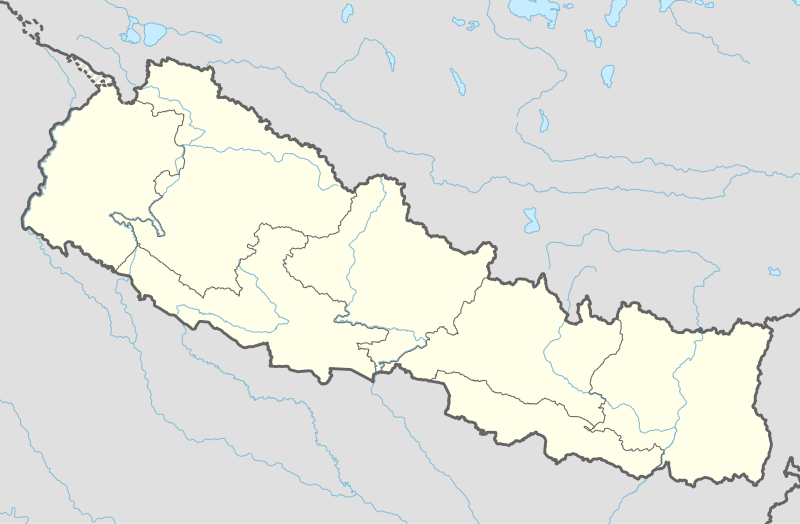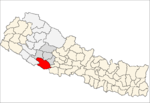Tulsipur, Dang
Tulsipur is a Sub-Metropolitan City in Dang District of Province No. 5 of Nepal. As per population, it is the district's second most populous city after Ghorahi. It was established in 1992 by merging the former Village development committees Tulsipur and Amritpur. In 2014, it was expanded and the Village development committees of Urahari, Tarigaun , Pawannagar and Halwar.[1] At the time of the 2011 Nepal census it had a population of 141,528 people living in 31,243 individual households.[2]
Tulsipur Sub Metropolitan City तुल्सीपुर उप महानगरपालिका | |
|---|---|
Sub-Metropolitan City | |
 Tulsipur Sub Metropolitan City Location in Nepal | |
| Coordinates: 28°07′40″N 082°17′44″E | |
| Country | Nepal |
| Provinces of Nepal | Province No. 5 |
| District | Dang District |
| Established | 1992 (2048 B.S.) |
| Government | |
| • Mayor | Anup Acharya (NCP) |
| • Deputy Mayor | Maya Sharma (NCP) |
| Area | |
| • Total | 384.63 km2 (148.51 sq mi) |
| Elevation | 725 m (2,379 ft) |
| Population (2015) | |
| • Total | 141,528 |
| • Density | 370/km2 (950/sq mi) |
| Languages | |
| • Local | Nepali, Tharu Bhasa |
| • Official | Nepali, Tharu Bhasa |
| Time zone | UTC+5:45 (NST) |
| Postal Code | 22412 |
| Area code(s) | 082 |
| Website | tulsipurmun.gov.np |
History
The House of Tulsipur ruled one of the largest Taluqs of Oudh, India, which then included the Dang and Deukhuri Valleys. Therefore, it also counted as one of the Baise Rajya (Nepali: बाइसे राज्य; 22 Principalities), a confederation in what became western Nepal. The Tharu civilization of sukaurakot (at the northern bank of Babai River) is one of the oldest human civilizations which was further extended to the eastern part of the country with the migration of the people of this community towards the east.
Transportation
Dang Airport lies in Old-Tarigaun offering flights to Kathmandu.[3] Roads go north into Salyan District and all the way to Rukum (also called Rapti-Babai Highway) giving its connectivity to Pahadi Lokmarg(Pan Nepal National highway being built up in districts in mountain, parrellal to the Mahendra Highway of Terai), 29 km south to the Mahendra Highway Amiliya in Deukhuri Valley and east to Ghorahi and west to Purandhara all the way connecting to Chhinchu, Surkhet. It is the major transit point of southern and western dang, Salyan, Rolpa and Rukum districts and serves as the transportation hub of whole rapti zone.
Local Transportation
The major source of transportation here are buses and jeeps. Nowadays electric auto rikshaw are also running as local transportation in market and town-side area. For the transportation of goods in villages, tractors are rampantly used though trucks are used in the major highways.
Media
To promote local culture Tulsipur has currently four FM radio stations. Radio Prakriti 93.4 MHz which is the first environment friendly community radio station, Radio Hamro Pahuncha - 89 MHz Which is a Community radio Station, Radio Tulsipur - 100.2 MHz which is a private radio station and Radio Sanjhibani-91.0. In addition there are also two local TV station STV and STN channels which broadcasts local events and news. Along with these, many daily and weekly local newspapers have been publishing. There is an online news provider channel that is tulasipur online Some newspapers which are publishing from Tulsipur are Gorakshya daily, Rapti Aawaj daily, Tharkot weekly, etc. The media presence in the city are listed below for the reference.
- 1. Radio Prakriti 93.4 MHz
- 2. Radio Hamro Pahuncha - 89 MHz
- 3. Radio Tulsipur - 100.2 MHz
- 4. Radio Sanjhibani-91.0
- 5. STN Television Channel
- 6. STV Television Channel
- 7. Rapti Aawaj National Daily
- 8. Gorakshya National Daily
- 9. Tharkot Weekly
- 10. Tulsipur Online
Education
The, then zonal headquarter of Rapti zone hosts various Government, Public-Private and Private educational institutions. Nepal Sanskrit University,NSU (formerly Mahendra Sanskrit University) is the only Sanskrit university and 2nd oldest University of Nepal which is well known all over Nepal and India for the quality of education it provides promoting the ancient Sanskrit, Vedic Astrology, Nepali Litreture education in Nepal. Students from all over Nepal, from Mechi to Mahakali use to come for vedic language study. It is mainly famous for its cost-effective, which can even be touted almost free, education in Sanskrit. Its main administrative office is located in Beljhundi whereas campus is in Bijauri. Other prominent institution includes Rapti Babai Campus which provides its facilities in various educational streams up to master's degree. Central Ayurvedic College, Rapti life Care Hospital's Staff Nurse programme is also very famous in the Region.
Similarly, Tulsi Boarding School, which is consistently ranked No. 1 in whole Mid-Western and Far-Western Region for its SLC results and well reputed in Nepal to have been awarded the prize of best School in the Mid-Western Region (best in 15 districts in the region). there educational Institutions in Tulsipur include Nepal Sanskrit University, Gorkha Higher Secondary School, Divine temple academy, Himal Academy, Aadarsh Academy, Novex College and Gyan Jyoti EDucation Foundation under which many school and college are running .
Healthcare
In Tulsipur, there is zonal level hospital named Rapti Zonal Hospital.
See also
References
- "पृष्ठभूमि तथा अवस्था" (in Nepali). Tulsipur Su-Metropolitan City. Retrieved 1 October 2018.
- "National Population and Housing Census 2011" (PDF). Central Bureau of Statistics. November 2017. Retrieved 1 October 2018.
- "Dang Airport" (PDF). Civil Aviation authority of Nepal. Retrieved 1 October 2018.
